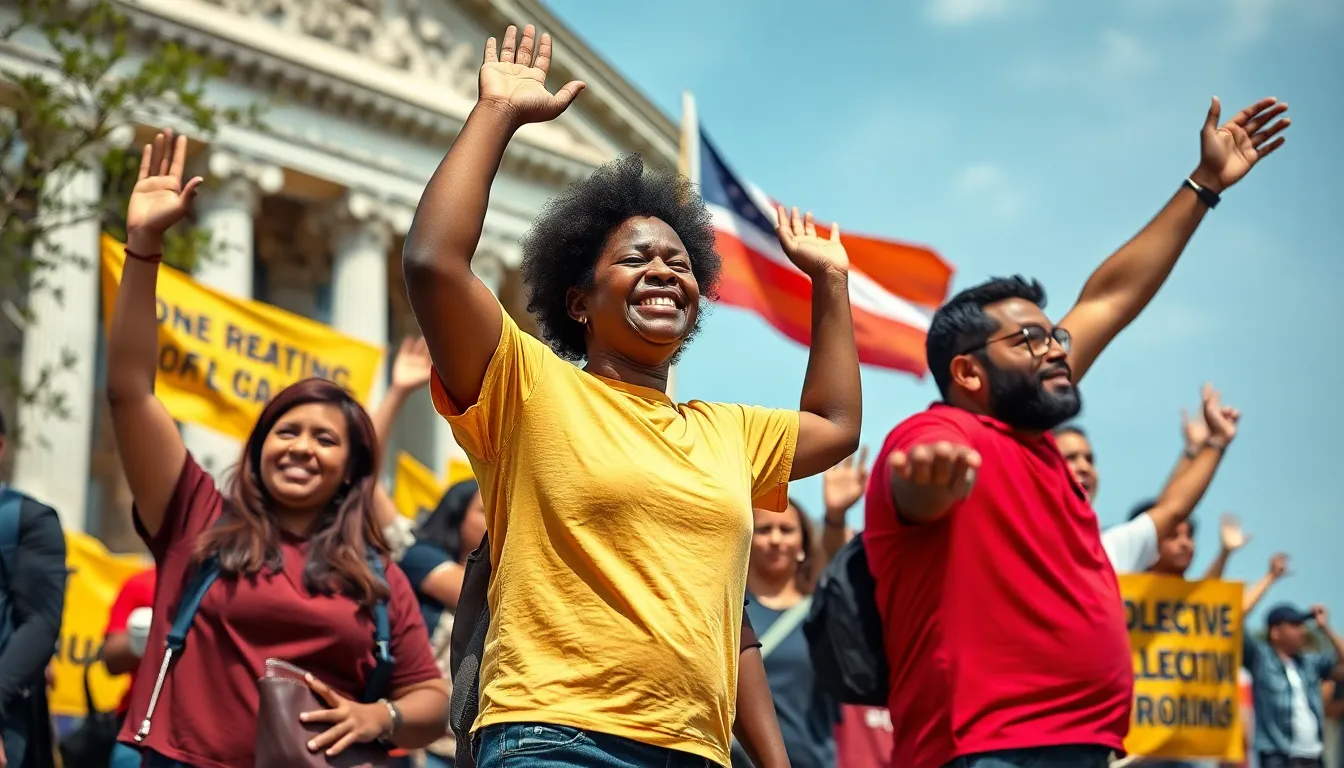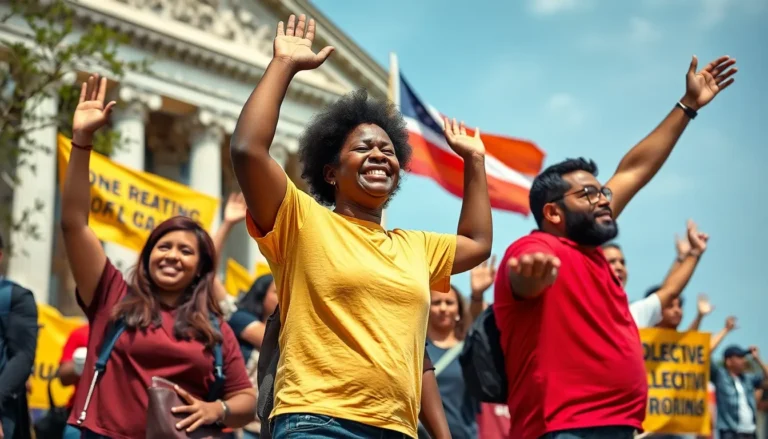Table of Contents
ToggleIn a world where negotiations can feel like a game of tug-of-war, collective bargaining rights stand as the lifeline for workers everywhere. Picture this: a group of enthusiastic employees banding together, armed with their voices instead of swords, ready to tackle the big bosses over fair wages and working conditions. It’s like a superhero team-up, but instead of capes, they wear hard hats and business casual!
Overview Of Collective Bargaining Rights
Collective bargaining rights enable workers to engage in negotiations with employers regarding employment terms. These rights are recognized as essential for fostering fair labor practices and promoting dialogue between management and employees. Through collective bargaining, employees can secure better wages, benefits, and working conditions.
In many countries, collective bargaining is a legally protected process. It empowers employees to organize and form unions for effective representation. When workers join together, they amplify their voices and create a platform for discussion on vital workplace issues. This unity often leads to improved outcomes, benefiting both employees and employers.
Collective bargaining agreements outline the specific terms negotiated between workers and management. These contracts may address various elements, including salary structures, hours of work, and health benefits. Each agreement reflects the unique needs and priorities of the workforce it represents.
Furthermore, the strength of collective bargaining lies in its ability to address systemic inequalities. Organizations that value employee input often see improved morale and increased productivity. Workers who feel heard and valued contribute positively to their workplace environment.
Specific legal frameworks support collective bargaining rights, such as the National Labor Relations Act (NLRA) in the United States. This legislation provides a governing structure for union activities and protects workers from unfair treatment related to union participation.
Collective bargaining rights serve as a cornerstone for workplace democracy. By facilitating effective negotiation processes, these rights help achieve equitable labor standards and foster a better relationship between employees and their employers.
History Of Collective Bargaining Rights
Collective bargaining rights have evolved significantly over time, reflecting shifts in labor relations and societal attitudes towards workers’ rights.
Early Developments
The roots of collective bargaining trace back to the late 19th century. Workers began to organize into unions, seeking better wages and conditions. Notably, the formation of the American Federation of Labor (AFL) in 1886 marked a pivotal moment. This organization aimed to unite skilled workers, emphasizing the importance of collective action. Strikes and protests became common as workers advocated for their rights. By the early 20th century, these efforts gained traction, leading to widespread recognition of labor’s collective voice in negotiations. Early labor movements laid the groundwork for legal protections that followed.
Key Legislation
Key legislation has shaped collective bargaining rights throughout the 20th century. The National Labor Relations Act (NLRA) of 1935 established critical protections for workers. This act guaranteed employees the right to form unions and engage in collective bargaining. The NLRA aimed to prevent employer interference in union activities. Other laws, such as the Labor Management Relations Act (Taft-Hartley Act) of 1947, further defined the parameters of collective bargaining. These legal frameworks established a more structured process for negotiations. They empowered workers to assert their rights while facilitating dialogues with employers.
Importance Of Collective Bargaining Rights
Collective bargaining rights play a vital role in shaping fair labor practices and enhancing workplace dynamics. These rights empower workers to negotiate their employment terms collectively.
Benefits For Workers
Workers experience numerous advantages through collective bargaining. Higher wages often result from union negotiations, reflecting the collective strength of employees. Improved benefits packages, including health care and retirement plans, become achievable through organized efforts. Job security increases as unions push for contractual protections against arbitrary dismissals. Additionally, a collective voice fosters a sense of community among workers, promoting solidarity and morale within the workforce. Increased workplace safety standards emerge from negotiations, ensuring healthier conditions.
Impact On Employers
Employers also benefit from collective bargaining in various ways. Collaboration with unions often leads to enhanced productivity, as satisfied employees contribute optimally to organizational goals. Clear, negotiated terms reduce conflicts, resulting in fewer disruptions and grievances. Engaging in collective bargaining fosters better relationships between management and workers, encouraging open communication. Employers experience positive public perceptions when they demonstrate commitment to fair labor practices and employee satisfaction. Moreover, adherence to collective agreements often mitigates legal risks associated with labor disputes.
Challenges Facing Collective Bargaining Rights
Collective bargaining rights encounter several significant challenges that hinder their effectiveness. Legal barriers often create uncertainty for workers seeking to exercise these rights.
Legal Obstacles
Legal obstacles manifest through restrictive regulations and interpretations of existing laws. These barriers may lead to reduced access to union formation and representation. Some jurisdictions impose stringent requirements, complicating the process for workers intending to negotiate terms or join unions. Certain court rulings can also erode rights meant to protect collective bargaining, thus challenging the standing of unions. These limitations can significantly affect workers’ ability to secure fair wages and working conditions.
Political Opposition
Political opposition represents another challenge for collective bargaining rights. Many policymakers oppose unionization efforts, arguing that they hinder economic growth. Legislative actions may affect the support for workers’ rights and diminish the power of unions. This opposition often results in laws that restrict union activities or provide limited legal protections for workers. Such an environment impacts employees’ willingness to organize, weakening collective bargaining’s influence in shaping labor relations. Political climates that favor employer interests typically stifle unions and undermine negotiations.
Future Of Collective Bargaining Rights
Collective bargaining rights face evolving challenges and opportunities. Understanding trends and advocacy strategies becomes essential for workers and organizers.
Trends And Predictions
Emerging trends indicate that collective bargaining rights will undergo significant changes in the coming years. Increased worker activism across various sectors highlights a resurgence of interest in unionization. According to recent studies, 48% of American workers expressed favorable views towards unions, reflecting a growing demand for representation. Digital platforms also facilitate organizing efforts, allowing workers to connect and share resources more easily. Remote work environments are likely to prompt new collective bargaining focuses, such as telework policies and home office stipends. Advocacy for equitable pay and benefits continues gaining momentum, with workers increasingly pushing for transparent compensation practices. The landscape of labor relations appears to shift toward greater inclusivity and responsiveness to worker needs.
Strategies For Advocacy
Effective advocacy for collective bargaining rights requires strategic approaches. Organizing local campaigns to educate workers about their rights is vital for enhancing participation. Building coalitions with community organizations enhances visibility and support for labor issues. Leveraging social media platforms enables broader outreach, making it easier to mobilize supporters quickly. Participating in public demonstrations emphasizes solidarity among workers and garners public attention. Engaging with policymakers to promote pro-labor legislation ensures collective bargaining rights are not eroded. Training union leaders in negotiation tactics strengthens bargaining positions, facilitating better agreements.
Conclusion
Collective bargaining rights are vital in shaping fair labor practices and empowering workers. They enable employees to unite and negotiate better working conditions and wages while fostering a more equitable workplace. As challenges arise, the resilience of workers and their advocacy efforts remain crucial.
The future of collective bargaining holds promise with increasing worker activism and innovative organizing strategies. By embracing these changes and educating employees about their rights, the collective voice can continue to drive positive change in labor relations. Ultimately, collective bargaining serves as a powerful tool for achieving workplace democracy and ensuring that all workers are treated fairly and justly.








